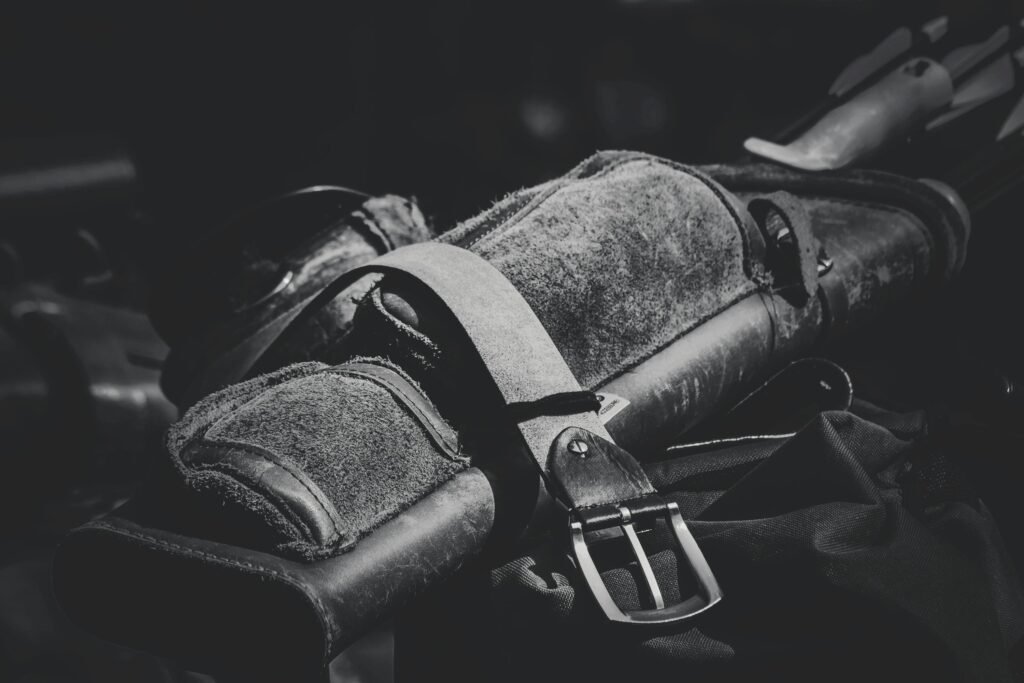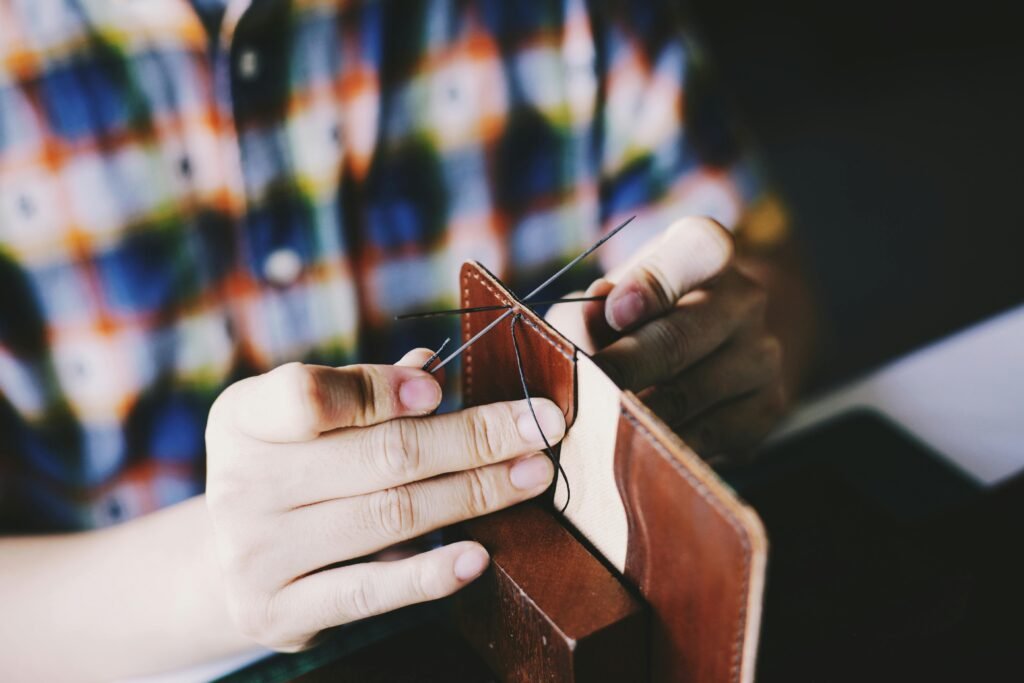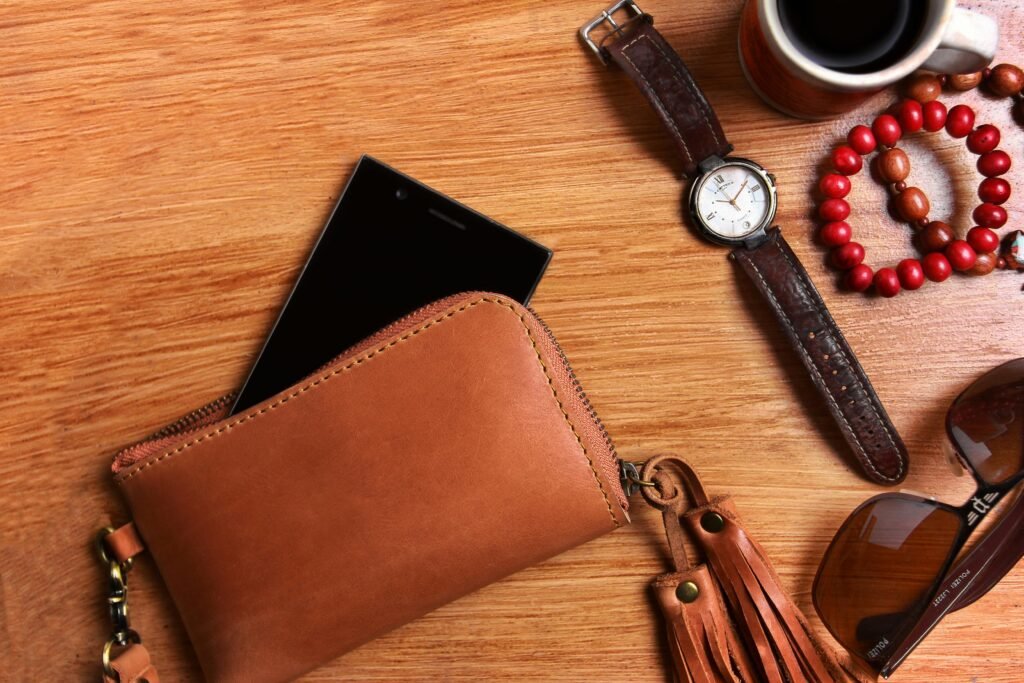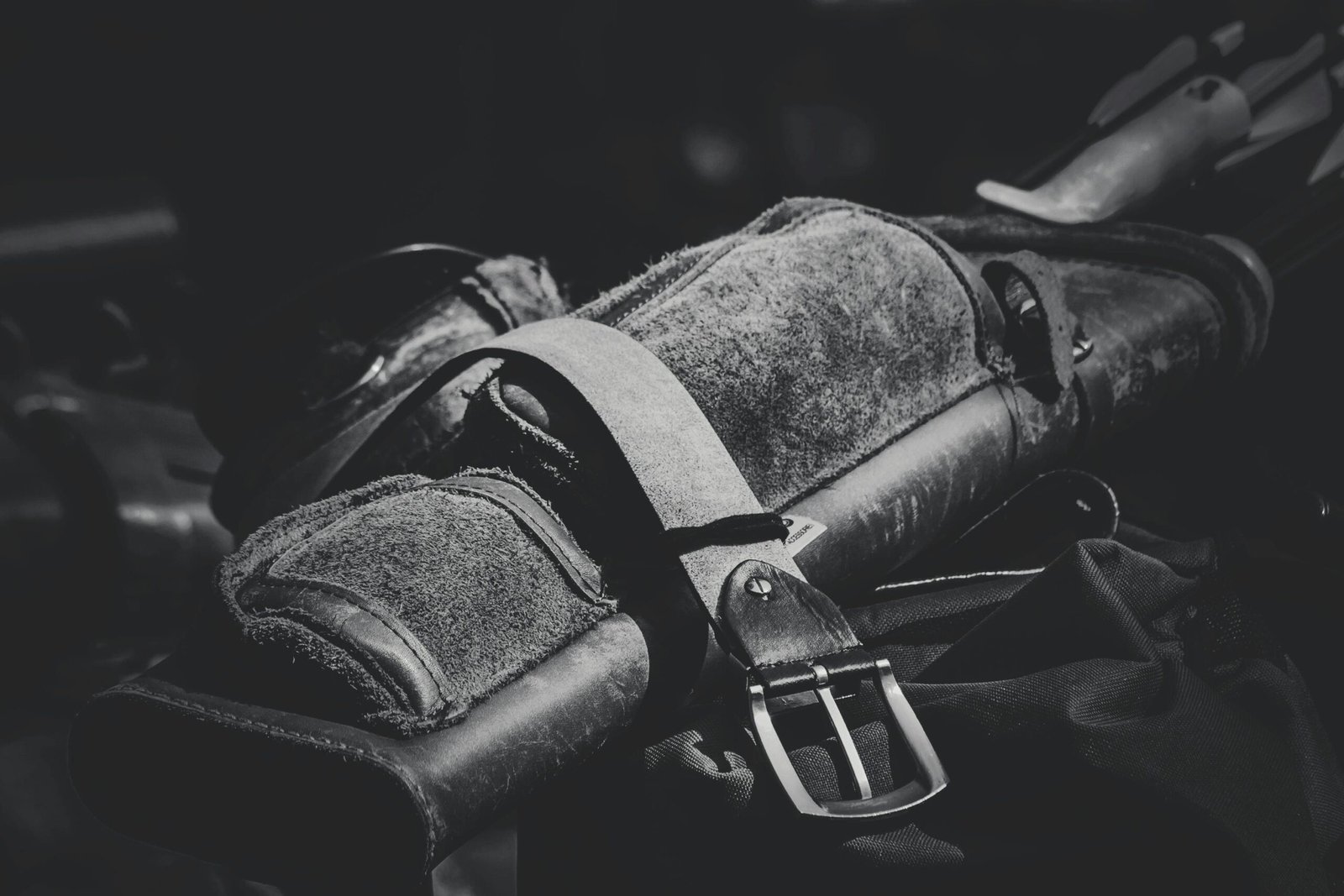Taking care of your leather wallet is a crucial factor in ensuring its longevity and maintaining its timeless appeal. In this article, you will find expert advice on how to care for your leather wallet, from cleaning and conditioning to storing and preventing damage. By following these simple yet effective tips, you can keep your leather wallet looking and feeling its absolute best for years to come. So, let’s dive into the world of leather wallet care and make sure your trusted companion stays in top-notch condition.

This image is property of images.pexels.com.
Cleaning Leather Wallets
Cleaning leather wallets is an essential part of maintaining their longevity and aesthetic appeal. Over time, dirt and debris can accumulate on the surface, making the wallet look dingy and worn out. Here are the steps you can take to effectively clean your leather wallet:
1. Remove dirt and debris
Start by gently brushing off any loose dirt and debris from the surface of the wallet. You can use a soft-bristled brush or a clean, dry cloth for this purpose. Be sure to remove any particles that might have settled in the crevices or stitching of the wallet.
2. Use a leather cleaner
Next, choose a high-quality leather cleaner that is specifically designed for cleaning and conditioning leather products. Avoid using harsh chemicals or household cleaning agents, as they can damage the leather and strip away its natural oils.
3. Apply the cleaner gently
Dampen a soft cloth or sponge with the leather cleaner and gently rub it onto the surface of the wallet. Use small, circular motions to work the cleaner into the leather, focusing on any areas that are particularly dirty or stained. Avoid excessive scrubbing, as it can cause the leather to become damaged or fade.
4. Wipe off excess cleaner
After applying the cleaner, use a clean, damp cloth to wipe off any excess product from the surface of the wallet. Make sure to remove all traces of the cleaner, as leaving it on the leather can lead to residue buildup and may result in a sticky or dull appearance.
5. Allow the wallet to air dry
Finally, allow the wallet to air dry naturally in a cool, well-ventilated area. Avoid placing it near direct heat sources such as radiators or hairdryers, as this can cause the leather to crack or warp. Once the wallet is completely dry, you can proceed with conditioning it for optimal care.
Conditioning Leather Wallets
Conditioning leather wallets is crucial for maintaining their softness and suppleness. Leather is a natural material that requires regular moisturization to prevent it from drying out and becoming brittle. Here’s how you can effectively condition your leather wallet:
1. Choose a leather conditioner
Select a reputable leather conditioner that is suitable for the type of leather used in your wallet. Different leather types may require specific conditioners, so it’s essential to read the product labels and follow the manufacturer’s recommendations. Opt for a conditioner that is formulated to deeply penetrate the leather and restore its natural oils.
2. Apply a small amount of conditioner
Take a small amount of the leather conditioner and gently apply it to the entire surface of the wallet using a clean, soft cloth. Ensure that you apply an even layer, paying extra attention to areas that may be prone to dryness, such as the corners and edges of the wallet. Use a moderate amount of pressure to work the conditioner into the leather.
3. Work the conditioner into the leather
Using small circular motions, massage the conditioner into the leather to allow it to penetrate deep within the pores. This will help restore moisture, flexibility, and shine to the wallet. Take your time and be thorough in ensuring that every inch of the leather is properly conditioned.
4. Allow the wallet to absorb the conditioner
Once you have applied the conditioner, allow the leather to absorb it for a few minutes. This will allow the conditioner to seep into the pores and nourish the material from within. The leather will appear slightly darker during this time, but it will eventually regain its original color as it dries.
5. Wipe off excess conditioner
Using a clean, dry cloth, gently wipe off any excess conditioner from the surface of the wallet. Be careful not to rub too aggressively, as this can disturb the leather’s natural grain and texture. Removing the excess conditioner will prevent any residue buildup, ensuring that the wallet maintains its sleek appearance.

This image is property of images.pexels.com.
Preventing Stains and Scratches
Preventing stains and scratches is essential for keeping your leather wallet looking pristine and in top condition. By taking a few precautionary measures, you can safeguard your wallet from potential damage and maintain its beauty for years to come. Here are some tips to follow:
1. Avoid contact with liquids
Leather wallets are highly susceptible to water damage and staining. To prevent any mishaps, avoid exposing your wallet to liquids such as water, oil, or alcohol. If your wallet does come into contact with any spills, be sure to follow the appropriate steps for cleaning and conditioning mentioned earlier.
2. Protect from direct sunlight
Excessive exposure to direct sunlight can cause the leather to fade and become discolored. Therefore, it is important to keep your wallet protected from prolonged exposure to sunlight. Store it in a cool, shaded area when not in use to preserve its original color and prevent premature aging.
3. Store in a dust bag
When not in use, consider storing your leather wallet in a dust bag or a soft, breathable pouch. This will protect it from dust, dirt, and other potential sources of damage. Avoid storing the wallet in plastic bags or airtight containers, as this can trap moisture and lead to mold or mildew growth.
4. Keep away from sharp objects
Leather wallets are prone to scratches and marks, so it’s important to keep them away from sharp objects or rough surfaces. Be mindful of where you place your wallet to avoid accidental damage. Consider carrying it in a dedicated pocket or compartment to minimize the risk of scratches.
By following these preventive measures, you can ensure that your leather wallet stays in excellent condition and maintains its timeless charm.
Dealing with Water Spills
Water spills can be quite a hassle to deal with, especially when it comes to leather wallets. However, there are steps you can take to address the issue effectively and prevent any damage to the leather:
1. Blot excess water with a towel
If your wallet gets wet, start by gently dabbing it with a clean, absorbent towel to remove as much excess water as possible. Avoid rubbing or wiping the leather, as this can spread the moisture and potentially damage the material.
2. Allow the wallet to air dry naturally
After blotting off the excess water, allow your wallet to air dry naturally in a well-ventilated area. Do not use any heat sources such as hairdryers or radiators, as this can cause the leather to shrink or crack. Patience is key during this process, as rushing it can lead to irreversible damage.
3. Avoid using heat sources
As mentioned earlier, it is crucial to avoid using heat sources to dry your wallet. Leather is a delicate material, and exposing it to high temperatures can cause it to become stiff and prone to cracking. Allow the natural airflow to dry the wallet and be patient throughout the process.
4. Condition the wallet after drying
Once the wallet has completely dried, it is recommended to condition it to restore any lost moisture. Follow the conditioning steps mentioned earlier to ensure that the leather remains soft and supple. Conditioning will help replenish the natural oils and maintain the overall health of the wallet.
By being proactive and following these steps, you can effectively address water spills and prevent any long-term damage to your leather wallet.

This image is property of images.pexels.com.
Treating Ink Stains
Ink stains can be particularly stubborn and problematic when it comes to leather wallets. However, with prompt action and the right approach, you can successfully treat ink stains and restore your wallet’s appearance. Here’s what you can do:
1. Act quickly
The key to treating ink stains on leather is to act quickly. As soon as you notice the ink stain, grab a clean cloth or paper towel and gently blot the area to remove any excess ink. Do not rub or spread the ink, as this can make the stain worse.
2. Apply a small amount of rubbing alcohol
Dampen a clean cloth with a small amount of rubbing alcohol. Make sure the cloth is only slightly damp, as using too much alcohol can damage the leather. Test the alcohol on a small, inconspicuous area of the wallet first to ensure that it does not cause any discoloration or damage.
3. Gently rub the stained area
Carefully rub the damp cloth over the ink stain in a gentle, circular motion. Be patient and continue to blot and rub until the ink begins to lift. Take care not to apply too much pressure or scrub vigorously, as this can cause the leather to become damaged.
4. Wipe off excess alcohol
Once the ink stain has faded, use a clean, dry cloth to wipe off any excess alcohol from the leather. This will remove any residue and prevent it from drying and causing a sticky or dull appearance on the wallet.
5. Condition the wallet after cleaning
After treating the ink stain, it is important to condition the leather to restore its moisture and suppleness. Follow the conditioning steps mentioned earlier to keep your wallet in optimal condition.
With prompt action and careful treatment, you can effectively remove ink stains from your leather wallet and maintain its pristine appearance.
Handling Grease and Oil Stains
Grease and oil stains are common culprits that can mar the appearance of leather wallets. However, with the right approach and a little patience, you can successfully remove these stubborn stains. Here’s what you can do:
1. Blot excess grease or oil
As soon as you notice a grease or oil stain on your wallet, use a clean cloth or paper towel to gently blot the excess. Be careful not to spread or rub the stain, as this can make it worse.
2. Sprinkle talcum powder or cornstarch
To absorb the remaining grease or oil, sprinkle a small amount of talcum powder or cornstarch directly onto the stain. Make sure to cover the entire affected area with a thin layer of powder.
3. Allow powder to absorb the stain
Leave the talcum powder or cornstarch on the stain for several hours or overnight. This will give it enough time to absorb the grease or oil from the leather. The powder will gradually change color as it absorbs the stain.
4. Brush off the powder gently
Using a soft-bristled brush or a clean, dry cloth, gently brush off the talcum powder or cornstarch from the leather. Be careful not to rub too aggressively, as this can cause damage to the surface of the wallet. The stain should noticeably fade or disappear after this step.
5. Condition the wallet after cleaning
After successfully removing the grease or oil stain, it is important to condition the leather to restore its moisture and flexibility. Follow the conditioning steps mentioned earlier to keep your wallet in optimal condition.
By following these steps, you can effectively handle grease and oil stains on your leather wallet and restore its original beauty.
Removing Scuffs and Scars
Scuffs and scars are common blemishes that can occur on leather wallets over time. However, with a few simple techniques, you can easily remove or minimize their appearance. Here’s what you can do:
1. Use a leather conditioner
Start by applying a small amount of leather conditioner to a soft cloth. Make sure to select a conditioner that is suitable for your wallet’s type of leather. Gently rub the cloth over the scuffed or scarred area, working the conditioner into the leather.
2. Apply a small amount to the affected area
If the scuff or scar is particularly stubborn, you can directly apply a small amount of leather conditioner to the affected area. Use your fingertips or a cotton swab to gently massage the conditioner into the leather, focusing on the blemish.
3. Rub gently in circular motions
Using circular motions, gently rub the leather conditioner into the scuffed or scarred area. This will help soften and blend the damaged spot with the rest of the wallet’s surface. Be patient and take your time working on the blemish, ensuring that the conditioner is absorbed by the leather.
4. Wipe off excess conditioner
After treating the scuff or scar, use a clean, dry cloth to wipe off any excess conditioner from the surface of the wallet. This step is important to prevent any residue buildup and maintain the overall appearance of the leather.
By following these steps, you can effectively remove or minimize scuffs and scars on your leather wallet, restoring its polished look.
Repairing Small Tears
Small tears in leather wallets can be unsightly and may compromise the wallet’s functionality, but they can be repaired with a little care and attention. Here’s what you can do to fix small tears in your leather wallet:
1. Clean the tear with a leather cleaner
Before repairing the tear, clean the affected area with a leather cleaner to remove any dirt or debris. Use a clean cloth or sponge to gently dab the cleaner onto the tear and surrounding area. Be careful not to rub, as this may aggravate the tear further.
2. Apply a leather adhesive or glue
Once the tear is clean and dry, apply a small amount of leather adhesive or glue to one side of the tear. Be sure to use a product that is specifically designed for leather repair. Carefully press the torn edges together, aligning them as closely as possible. Hold the edges in place for a few minutes to allow the adhesive to bond.
3. Press the torn edges together firmly
To ensure a strong bond, press the torn edges of the leather together firmly using your fingers or a small tool, such as the edge of a spoon. This will help secure the tear and prevent it from reopening.
4. Allow the adhesive to dry completely
After pressing the torn edges together, allow the adhesive to dry completely. Follow the manufacturer’s instructions regarding drying time, as it can vary depending on the type of adhesive used. Patience is crucial during this step to ensure that the repair is strong and lasting.
5. Condition the wallet after repair
Once the adhesive has dried, condition the leather wallet to restore any lost moisture and flexibility. Apply a small amount of leather conditioner and gently massage it into the repaired area, as well as the rest of the wallet. This will help blend the repaired section with the rest of the leather and maintain its overall appearance.
By following these steps, you can effectively repair small tears in your leather wallet and extend its lifespan.
Preventing Mold and Mildew
Leather wallets are prone to mold and mildew growth in damp conditions. To prevent the growth of these unsightly and potentially damaging fungi, here are a few preventive measures to keep in mind:
1. Keep the wallet in a dry environment
Ensure that your leather wallet is stored in a dry environment to prevent moisture from seeping into the material. Avoid leaving it in humid areas such as bathrooms or basements, as the excess moisture can lead to mold and mildew growth. Instead, store the wallet in a cool, dry location.
2. Avoid storing in airtight containers
Leather needs to breathe, so avoid storing your wallet in airtight containers or plastic bags. Lack of ventilation can create a humid environment that is conducive to mold and mildew growth. Opt for breathable storage options such as dust bags, fabric pouches, or open containers.
3. Use silica gel packets or cedar chips
To further prevent moisture buildup, consider placing silica gel packets or cedar chips in the vicinity of your wallet. Silica gel packets are excellent at absorbing excess moisture, while cedar chips act as natural deodorizers and help repel insects. These simple additions can help keep your wallet dry and mold-free.
4. Inspect the wallet regularly
Regularly inspect your leather wallet for any signs of mold or mildew. Pay close attention to areas that are more prone to moisture buildup, such as folded corners or creases. If you notice any suspicious spots or a musty odor, take immediate action to address the issue and prevent further mold growth.
By following these preventive measures and maintaining a dry environment for your leather wallet, you can effectively prevent the growth of mold and mildew.
Professional Maintenance
While regular cleaning and conditioning can go a long way in maintaining the condition of your leather wallet, there may come a time when professional intervention is necessary. Here are some reasons why you might consider seeking professional maintenance for your leather wallet:
1. Consult a professional leather cleaner
If you are unsure about the best course of action or have concerns about cleaning or repairing your leather wallet yourself, it is advisable to consult a professional leather cleaner. They have the expertise and knowledge to assess your wallet’s condition and recommend the appropriate maintenance procedures.
2. Get wallet professionally cleaned and conditioned
Professional leather cleaners have specialized tools and products to deep clean and condition leather items. Taking your leather wallet to a professional ensures that it receives a thorough cleaning and conditioning treatment, without the risk of damage that can be caused by improper techniques or products.
3. Ask for repair recommendations
If your leather wallet has significant damage or requires repairs that you cannot handle yourself, a professional can provide recommendations for trustworthy repair services. They can assess the extent of the damage and advise on the best repair options to restore your wallet to its former glory.
4. Follow manufacturer’s instructions
When seeking professional maintenance, it is crucial to follow any specific instructions provided by the wallet’s manufacturer. Different leather products may require different care methods and techniques. By adhering to the manufacturer’s guidelines, you can ensure that your wallet receives the most appropriate and effective treatment.
Remember that prevention is key, and investing in regular professional maintenance can help extend the lifespan of your leather wallet and keep it looking its best.
In conclusion, caring for your leather wallet involves regular cleaning, conditioning, and preventive measures. By following the provided steps, you can keep your wallet clean, well-maintained, and free from stains and damages. Remember to handle spills promptly, treat stains accordingly, and seek professional help when necessary. With proper care, your leather wallet will continue to exude elegance and durability for many years to come.
